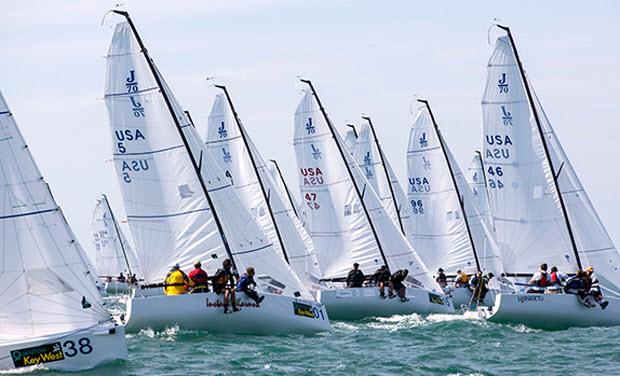

It’s important to remember that a bad start is not the end of your day, patience and keeping a cool head will generally save you from a total disaster. You can recover from a bad start.
Look for a clean exit
If your start has gone wrong, don’t panic and look for a clean exit sooner rather than later.
Be patient though, a hasty change to your pre-determined plan without considering all options may actually place you in an even worse situation.
Two things that are critical to an effective recovery are that the helmsperson must continue to sail the boat as fast as possible all the while deciding where to get clean air.
Depending on your situation though, sheets should be trimmed for footing or pointing, you need to make decisions based on what you are seeing up the track.
If you find yourself in the second row, you need power because there is less wind and more chop. The backstay needs to be eased and Cunningham released. Then the jib leads need to be moved forward to get a fuller, more powerful headsail.
The Most Common Escape To Recover From A Bad Start
The most common escape starts with gentle pinching in an attempt to get above the boats to leeward , to do this, move the traveller up and sheet a tick or two tighter than the conditions require.
This cannot be maintained for too long though and the desired result is an escape to clean air. The goal being to find a lane in which you can live in for at least two minutes.
If you need to tack for clearer air, make sure there is no one that will tack on your wind. Watch the boats around you for crew movement that may indicate a change in their direction that will affect you.
Once you have a clear lane and are now going in the planned direction, look at the fleet to see if that plan is falling into place and if not be prepared to alter the plan to suit.
If you have a bad start near the weather end it is easy to tack away to clear. Then tack back again as soon as there is a lane if you are looking to go left.
Recover from A Poor Start Midline
A poor start in the middle of the line in more difficult to extricate yourself from and generally occurs when you are late due to line sag or when a port tack boat tacks under you and establishes a lee bow.
Generally, it is a mistake to foot off below the boat on your lee bow. Conversely do not tack too early because you will then have to dip the boat to weather. That boat then has a chance to tack on your air.
If you have to bail out at the leeward end there are few options. Clearing out to the right is rarely an option as you will have the bulk of the fleet on starboard.
If you are at the pin end and your plan was to head left, crack off a little to get speed and get to clear air as soon as possible.
Cracking off for clear air, generally only works if there are a small number of boats below you. It will take an eternity to reach clear air if in fact you ever do.
If you are forced to bail out, be patient and wait for the proper clear lane to get right. All the time keeping the boat moving fast.
Once on Port tack, you can look for another lane to tack back to the left.
#sailingtowin #sailtowin #sailing #sail #yachtrace #sailingcoach
FREE BOOK! TIPS FROM SAILING LEGENDS

